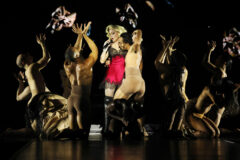As we prepare for — and, in some cases, reorganize — Madonna’s 13th studio album, Rebel Heart, it’s tough not to refect on the 56-year-old pop icon’s career as a whole. As someone who’s been playing the Top-40 game since 1983, Madge is one of the finest and most-referenced examples of long-term success in this youth-obsessed industry. And for good reason, too: She’s been a Material Girl; a Coke-can-curled, lipsticked movie star; barrier-crossing creator of the original Sexy Book of Sexy Sex; a ’90s raver; a dancehall queen; an all-American girl; a Yoga mat-toting goth chick; and more. And so, as she shakes off the phoenix ashes and opens up her Rebel Heart, SPIN’s staff and contributors opened up a debate: What is Madonna’s greatest era?
Material Madonna (1982-1985)
https://youtube.com/watch?v=SXPMLTmpPpY
Sure, in the three-plus decades since she hit the pop landscape with the force of an Armageddon-sized asteroid, Madge has donned a variety of guises, both musical and visual. But close your eyes and ears for a second and just let the word Madonna flash across your brain. What does it conjure? Be honest: It’s black-lace, crucifix necklace, blonde-hair-over-one-eye Madonna. It’s sparkly synth, bubbly melody, orgasmic “HEY!” Madonna. It’s wedding dress at the VMAs Madonna. It’s pyramid jacket Madonna. It’s writhing around in the middle of the street Madonna. It’s “Lucky Star” Madonna. Hell, it’s self-titled Madonna, because it’s the purest and most self-evidently Madonna.
First looks aren’t always the best looks, and I certainly wouldn’t suggest that Madonna should have stayed in her Boy Toy phase in perpetuity. But when your initial impression includes about a dozen timeless pop smashes over the space of three years, with just as many iconic videos, live performances, and fashion statements to match, the best you can hope to do is maintain that A+. More than 30 years later, we’re still living in a material world, and Madonna is still the Material Girl, first and foremost. — ANDREW UNTERBERGER
Retro Madonna (1986-1990)
https://www.youtube.com/embed/GsVcUzP_O_8
Madonna is nothing if not a master of transformation. When True Blue was released in 1986, gone were the staccato squeals and breathy, cotton-candy vocals, the smudged eyeliner, Aussie scrunch spray, and sweaty wedding dress. Over the second half of the decade, her voice progressively got deeper and richer, and her aesthetic tended toward classic red lipstick, pin curls, and sleek pantsuits favored by 1930s screen stars like Marlene Dietrich, who Madonna namechecks in “Vogue.”
Yet Madonna always has and always will be subversive: Underneath those blazers were conical bras, and when she dreamed up a fan dance worthy of Marie Antoinette’s royal court for her 1990 VMA performance, dancers groped her breasts and she flashed the audience. Most controversial, of course, was her crucifix-flashing video for “Like a Prayer,” which resulted in Pepsi pulling their sponsorship and the outrage of the entire Catholic church. But the most lasting impression from this era? Madonna as a powerful new feminist icon, as exemplified in the David Fincher-directed “Express Yourself.” She showed us that women could grab their crotches without emasculating their men, that being smart in the boardroom and submissive in bed weren’t mutually exclusive. In short, she showed us that yes, women run the world, but without men, the world wouldn’t be as much fun. — REBECCA HAITHCOAT
Sex Madonna (1992-1994)
https://www.youtube.com/embed/JUII7DTACf4
So this is where I’m supposed to say Madonna’s best look was when she absconded with clothes altogether. Here’s the thing: Whether you’re six or 76 years old, the one word you always hear in association with Madonna is “sex.” That was the word the most famous person in the world circa 1992 chose to title her now-gone book, which you and I have never seen because we’re not paying quasi-Once Upon a Time in Shaolin numbers on EBay to look at nudes of Vanilla Ice in 2015. But we know about it nonetheless, because Madonna = S-E-X. Sex in the fourth grade sense, yes: There’s a “dirty fuck” mix of “Erotica” that seems to only exist so she can say the F-word (and the original itself has at least 43 or 44 shades of gray).
But Sex also contained plenty of evidence that all the way back in 1992 she knew more than us with regards to the titular subject: “Everyone has their sexuality. It’s how you treat people in everyday life that counts, not what turns you on in your fantasy.” The censorship squabbles over the “Justify My Love” and “Erotica” clips overshadowed the fact that the downtempo and house-laden Erotica is arguably her best album, with the bad fortune to be released at the moment that everyone was kind of sick of her. And while she remains fully dressed the entire time, the “Bad Girl” video ends with what I am absolutely positive looks like Christopher Walken and Madge flying away with jetpacks. — DAN WEISS
Evita Madonna (1996)
Playing Eva Perón in the movie adaptation of Evita was arguably the apex of Madonna’s hit-or-miss acting career, which up to that point had found her playing a series of wisecracking tough girls, sexpots, and petty criminals. (Eternal respect and adoration to her turn as “All the Way” Mae in A League Of Their Own, however.) On paper, her playing the First Lady of Argentina wasn’t much of a stretch; after all, both women were a bundle of contradictions who teetered between high and low culture with relative ease. (In her epic Vanity Fair Evitadiaries, Madonna noted: “It seems our dear Evita liked to drink beer and go to boxing matches. A girl after my own heart!”)
Yet Madonna’s exhaustive first-person research for the role (which included traveling to Argentina to grill locals who knew Eva, to make sure she did Perón’s life justice) illustrated her tireless work ethic, something often overlooked because of her provocation. She never slacked on any aspect of being Madonna, and always strived to push herself forward as an artist and as a person. In fact, her performances on the Evita soundtrack demonstrated her astronomical growth as a vocalist — from the operatic Broadway trilling on “Rainbow High” and her fragile-sounding pleas on the Oscar-winning “You Must Love Me” to a nuanced but proud take on the iconic ballad “Don’t Cry For Me Argentina.” Really, Evita marked the start of Madonna’s Serious Phase, one where she balanced youthful coquettishness with a more mature, introspective outlook. This period was probably her most ephemeral epoch, but it had long-lasting implications. — ANNIE ZALESKI
Kabbalah Madonna (1997-2002)
At the time, it was a little too easy to crack jokes at Madonna’s seemingly faddish turn with Jewish mysticism, but her level of commitment, on the other hand, was — and still is — something to take seriously. Madge didn’t express herself by flitting off to superficial vision quests; she took the study of Kabbalah, Hinduism, Buddhism, and Yoga to a, erm, higher place on 1998’s Ray of Light, a rave- and techno-inspired album that helped turn the aforementioned spiritual movements into household names and, in some cases, front-page tabloid fodder. (Especially Kabbalah — remember when Ashton Kutcher had a red bracelet?)
West Coast superficialities (and my lame puns) aside, electronica owes something of a debt to Kabbalah Madonna’s shift in sound on Ray of Light. The clever use of computer blips and techno effects on songs like the strobing title track, “The Power of Good-Bye,” and the gothy “Frozen” (thanks in part to producer William Orbit) helped cement the mainstream crossover of a dance culture once relegated to illegal basement parties. Even better, the world even got to watch her play a game of sexy chess with Clive Owen in the video for “The Power of Good-Bye.” — RACHEL BRODSKY
All-American Madonna (2002-2004)
If we’re facing facts here, it’s that American Life — and to a small extent, Confessions on a Dance Floor — was the end of Madge’s cutting-edge, controversial-for-a-reason phase. On snarky, snarling songs like “Hollywood” and “American Life” itself, the undisputed Queen of Pop sharpened her knives mid-fight and slashed at targets like the star system, religion (“I just realized that nothing is what it seems”), and conformity.
Honestly, I miss this Madonna. Go back and watch her VMAs performance with Britney Spears and Christina Aguilera as the trio slithered and stomped across a stage as a shocked nation — Justin Timberlake, we’ll never forget that face — sat back wordless. It was attention-getting, but done pointedly, as if Madonna were grabbing the world by its face and screaming, “Restrictions mean nothing. Status means nothing. Love is love and individuality is key.” — BRENNAN CARLEY

.png)



